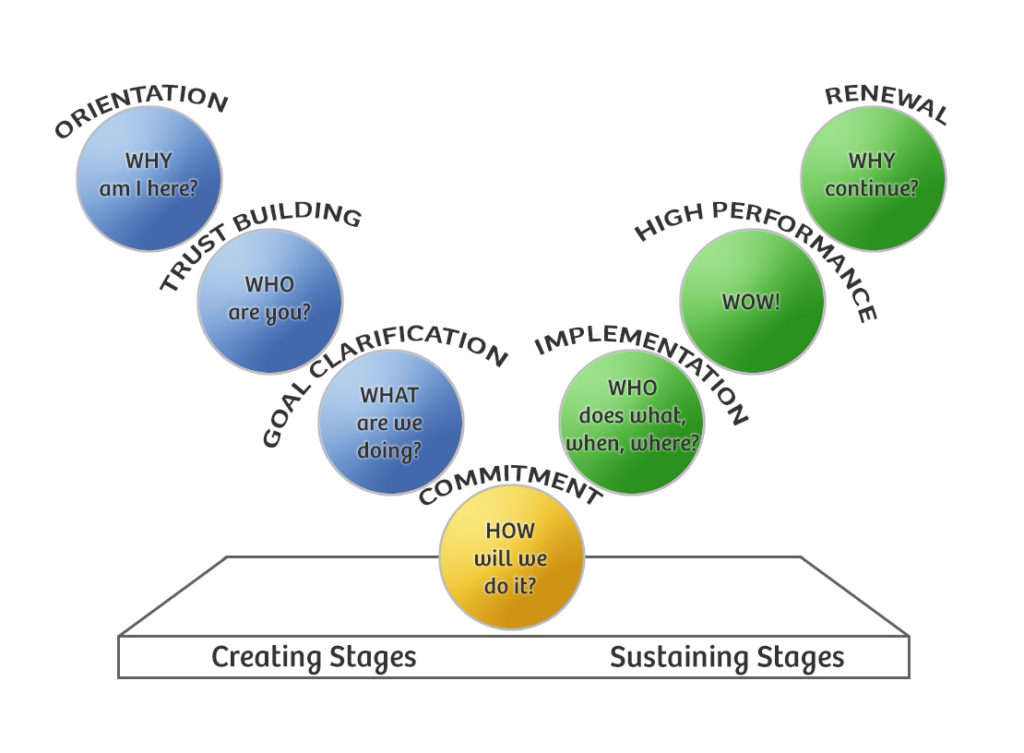What It Is:
Attributed to Allan Drexler and David Sibbet of The Grove Consultants International (1990)
The Drexler/Sibbet Team Performance Model, also known as the Team Performance Curve, is a framework developed by Allan Drexler and David Sibbet. This model provides a visual representation of the stages a team goes through in its development and the associated performance and dynamics at each stage. The model is often presented as a curve with seven stages. Here are the stages typically associated with the Drexler/Sibbet Team Performance Model:
- Orientation (Inclusion):
- Characteristics: Politeness, getting to know each other.
- Focus: Building a sense of belonging and inclusion within the team.
- Dissatisfaction (Divergence):
- Characteristics: Conflicts, skepticism, competition.
- Focus: Addressing differences and resolving conflicts to establish trust.
- Integration (Convergence):
- Characteristics: Cooperation, team spirit.
- Focus: Finding common ground and working together effectively.
- Production (Clarity):
- Characteristics: Productivity, goal-oriented.
- Focus: Achieving tasks efficiently and delivering value.
- Solution (Unity):
- Characteristics: Creativity, innovation.
- Focus: Generating new ideas and solving complex problems.
- Affirmation (Synergy):
- Characteristics: Trust, mutual support.
- Focus: Building on strengths, continuous improvement.
- Renewal (Interdependence):
- Characteristics: Reflection, celebration, learning.
- Focus: Reflecting on accomplishments, learning from experiences, and preparing for new challenges.
How to Use It:
Using the Drexler/Sibbet Team Performance Model in Agile Coaching:
- Team Assessment:
- Use the model to assess where the team currently stands in its development. Identify the predominant characteristics and dynamics.
- Intervention Strategies:
- Tailor coaching interventions based on the team’s current stage. For example, if the team is in the Dissatisfaction stage, focus on conflict resolution and building trust.
- Setting Expectations:
- Help team members understand that it’s natural for teams to go through various stages. Discussing the model can set realistic expectations about the challenges and successes that may arise.
- Facilitating Workshops:
- Conduct workshops or retrospectives using the model as a framework. Team members can discuss their experiences and challenges within the context of the model.
- Communication Strategies:
- Adjust communication strategies based on the team’s stage. For instance, in the Dissatisfaction stage, emphasize active listening and addressing conflicts.
- Building Trust:
- Focus on trust-building activities if the team is in the early stages, such as Orientation or Dissatisfaction.
References:
Resources on Drexler/Sibbet Team Performance Model:
- Books by Allan Drexler and David Sibbet:
- “The Seven Challenges of Building High-Performing Teams” is a book by Drexler and Sibbet that delves into the Team Performance Model.
- The Grove Consultants International:
- Allan Drexler and David Sibbet founded The Grove Consultants International. Their official website may offer resources, publications, or workshops related to the Team Performance Model.
- Workshops and Training Programs:
- Look for workshops or training programs facilitated by Allan Drexler, David Sibbet, or organizations that specialize in the Team Performance Model.
Visit the Agile Coach’s Toolkit for more definitions, models, theorems and stuff.

